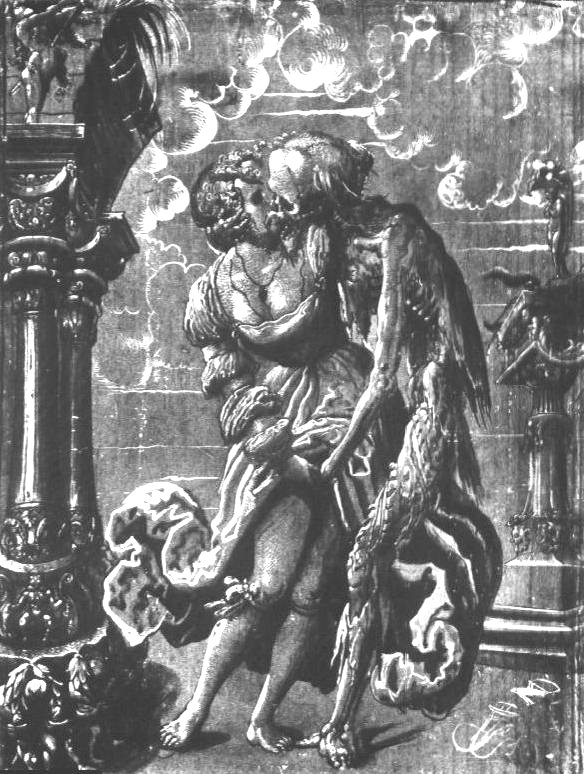
Vampire Romances are a fascinating aspect of the Romance Genre. They have mysterious heroes that are tortured by a traumatic past. As Anne Stuart explains, “At the heart of the vampire myth is a demon lover who is both elegant and deadly, a creature whose savagery is all the more shocking when taken with his beauty and style.”[i] In vampire romances the stakes are high- not only if the heroine fighting for love, she’s fighting for her hero’s soul and her life. Vampire romances invoke an older, intertexual tradition of attraction between a Maiden and Death.
Stories of maidens and Death are not new. The “Dance of Death” motif in the 14th century was a popular motif in
a popular motif in
Another more modern narrative of death and the maiden is Joyce Carol Oates’s “Where Are You Going, Where Have You Been?” In the story Arnold Friend, a strange unknown man with alluring qualities, persuades Connie, a young girl, to leave her house and come with him in his car. A close reader concludes by the end of the story that if Connie goes with
How then, does Vampire Romance fit into all of this? Vampire Romances have a hero that is a fallen angel- with aspects of both life and death. Anne Stuart, author of vampire romances explains, “The heroine’s attraction to the hero is never in doubt,”[vii] just like the attraction of Death in Death and the Maiden is not in doubt. Yet in vampire romance novels the authors twist the previous narrative tradition. There is still a sense of the inevitable in vampire romances, but the inevitable isn’t the eventual death of the heroine. Rather love is the inevitable consequence of the eroticism and attraction between a hero intimately connected with death and a heroine with life. Conflict in the vampire romance centers around the hero’s struggle with not wanting to damn his love (either by making her a vampire or killing her), and his eventual conquering of his monstrous instincts because of his love of the heroine. Love is the force that conquers the vampire’s monstrous nature, and prevents the hero from destroying the heroine. By rewriting the traditional Death and the Maiden narrative, romance novel authors create a new text that is life affirming and love affirming. They send the message that love transcends death.
[i] Anne Stuart, “Legends of Seductive Elegance,” in Dangerous Men and Adventurous Women, ed. Jayne Ann Krentz (Philadelphia, University of Pennsylvania Press, 1992), 85.
[ii] Randy Nelson, “Monsters, Heroes, and the End of Fairy Tales,” Davidson College Metafiction and Intertextuality class, September 10, 2008.
[iii] Niklaus Manuel Deutsch, Death and the Maiden 1517.
[iv] Hans Sebald Beham. Death and the maiden; la mort se saisissant d'une femme nue et debout.
[v] Hans Baldung (1484/5-1545). 1517. Death and the maiden.
[vi] Joyce Carol Oates, "Where Are You Going, Where Have You Been?," in Retellings, ed. M.B. Clarke and A.G. Clarke (
[vii] Anne Stuart, “Legends of Seductive Elegance,” in Dangerous Men and Adventurous Women, ed. Jayne Ann Krentz (Philadelphia, University of Pennsylvania Press, 1992), 86.
Pictures from http://www.lamortdanslart.com/fille/maiden.htm. The First is Death and the Maiden by Niklaus Manuel Deutsch painted in 1517, and the second is the frescoe of Berne.
On another note, how eerie is it that the Death and the Maiden Paintings echo some romance novel covers in the way the two figures are positioned? Am I the only one seeing the similarity?